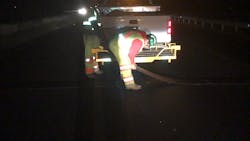MassDOT tests rumble strips
The Massachusetts Department of Transportation (MassDOT) tested PSS RoadQuake 2F Temporary Portable Rumble Strip (TPRS) during the week of Oct. 31, 2016. MassDOT wanted to test the product in a live work zone, as part of their approval process.
MassDOT conducted the tests to resolve, in live traffic, three basic issues:
- First, as RoadQuake TPRS is not glued or otherwise affixed to the road, that their movement in live traffic is minimal.
- Second, that TPRS arrays alert drivers, with significant sound and vibration, to changing road conditions, like upcoming lane closures.
- Third, in addition to alerting drivers, that TPRS might slow them down.
The tests took place at night on S.R. 128, on a paving project. The paving work zone was active on S.R. 128 at the Dodge Street exits, Exits 20A and 20B, near Milemarker 43, in Beverly, northeast of Boston. S.R. 128 is a divided highway, with 2 lanes in either direction. The posted speed limit is 55 mph.
On the first test night, workers from the paving contractor, Aggregate Industries, installed 2 arrays of RoadQuake 2F TPRS in the eastbound lanes. To install the strips, workers used RoadQuake CRIB Cargo Carrier (see photos).
Workers installed one array in the passing lane and one in the travel lane, with the arrays adjacent to each other. The array location, adjacent to an entrance ramp, was about 1,200 ft ahead of the lane closure taper and the workers’ location. To accommodate travel speeds of 55 mph and above, and ensure optimal performance to alert drivers, aggregate workers placed each strip 20 ft apart in the arrays, per the PSS RoadQuake TPRS “Best Practices” Guidebook.
The crew drew lines with chalk to mark the original locations of the strips to measure any movement caused by live traffic. Movement the first night was negligible and well within PSS specifications; so much so that the crew did not bother to mark the strips the second night.
Also, on that first night, workers and MassDOT engineers near the arrays could hear approaching traffic crossing the strips. They knew the sound and vibration was significant. They also saw most drivers reacting to the TPRS arrays; several looked up and around quickly, as if startled.
Last, they saw drivers slow down upon approaching the arrays, with some riding their brakes once beyond the arrays.
The second night, workers again installed two arrays, in the same location as the night before. They then added two more, installing one array in the entrance lane to S.R. 128, as it merges into the other two arrays. There were three arrays adjacent to each other across three lanes. The arrays would alert drivers that the road would soon be reduced to one lane.
A fourth array was installed in an open lane within the work zone itself, after the lane closure, at about 500 ft before the location of the workers in the work zone. This array, which constitutes a second set of arrays, a second line of defense, proved valuable to those in the work zone.
A second line of arrays tells drivers that the first line has been installed, intentionally, to protect them. The second line also warns drivers that they will soon approach another change in the road conditions; in this case, with this array in the work zone, it is the presence of workers. As such, drivers are alerted that they should not yet resume normal highway speeds. Last, workers nearby can hear the sound of vehicles driving over TPRS arrays; this second line of arrays alerts workers that traffic is approaching.
A state trooper on site, with blue lights off, took radar readings of 43 vehicles as they approached an array, and then once beyond the array. While this in no way is considered a scientific sample, the readings offer yet more powerful anecdotal evidence that RoadQuake TPRS reduces drivers’ speeds.
Four drivers were recorded traveling over 70 mph, 15 mph over the speed limit. The fastest of these four drivers then showed a reduction in speed of 28 mph. One very consistent driver showed a speed of 44 mph approaching the array and 44 mph beyond.
The average speed reduction in this sample was 7.8 mph, which is a number consistent with previous studies conducted by university researchers. We discussed two such studies in case studies published earlier this year, here and here.
After the tests, a MassDOT engineer wrote:
“This is very good news for us, as [the rumbles strips are] proving to be effective in keeping drivers alert…and as a side benefit, resulting in a slight decrease in the travel speeds. To me the notion of someone paying attention and being alert to the road construction might encourage better compliance to the speed limit on its own merit…TPRS arrays just further enhance that behavior.”
